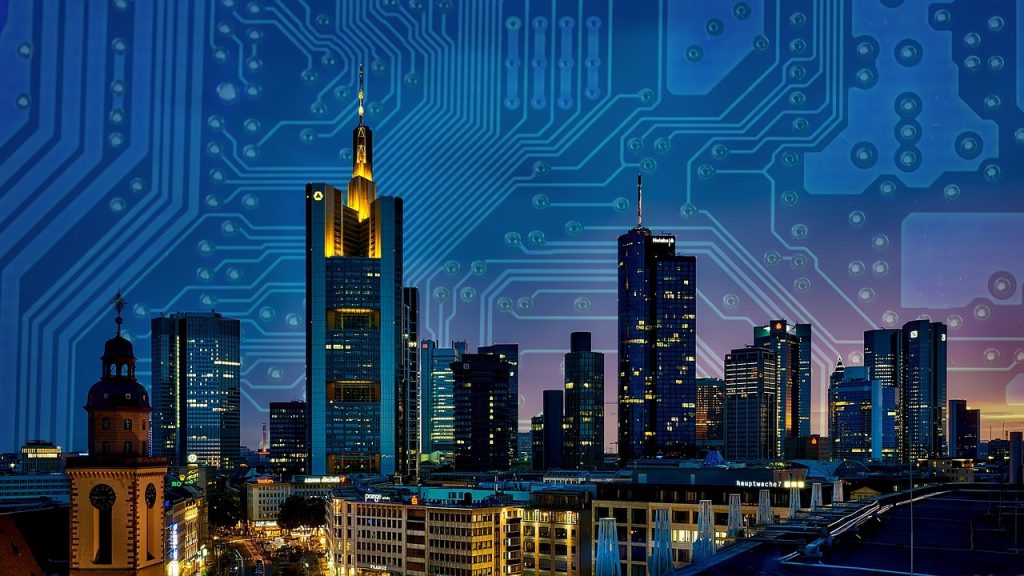Have you ever wondered how technology is transforming cities into smart, efficient, and interconnected hubs? In this article, we will explore the rise of smart cities and how they are integrating the power of Artificial Intelligence (AI), Internet of Things (IoT), and Big Data to revolutionize urban living. From optimizing transportation systems to improving energy management and enhancing public safety, this innovative fusion of technology is reshaping the way we experience and interact with our urban environments. Join us as we delve into the exciting world of smart cities and discover the endless possibilities they hold for a more sustainable and connected future.

Smart Cities: An Introduction
Welcome to the world of smart cities! In this article, we will explore the fascinating realm where technology and urban living intersect. Smart cities bring together the power of Artificial Intelligence (AI), Internet of Things (IoT), and Big Data to create more efficient, sustainable, and livable urban environments. By leveraging these innovative technologies, cities around the world are transforming the way we live, work, and connect with each other.
The Convergence of AI, IoT, and Big Data
To truly understand the impact of smart cities, we must first delve into the convergence of AI, IoT, and Big Data. These three cutting-edge technologies work hand in hand to optimize various aspects of urban life, from transportation and energy management to waste disposal and public safety.
AI in Smart Cities
Artificial Intelligence plays a crucial role in the development of smart cities. By harnessing advanced algorithms, machine learning, and deep learning, AI enables cities to automate processes, make data-driven decisions, and enhance the overall quality of life for residents. AI-powered systems are being utilized in areas such as traffic management, energy usage optimization, waste management, surveillance, and public transportation.
IoT in Smart Cities
The Internet of Things, often referred to as IoT, connects various devices and objects through the internet, enabling them to collect and exchange data. In smart cities, IoT facilitates seamless communication between different infrastructure components, allowing for smarter management of resources and systems. Connected infrastructure, smart grids, buildings, parking solutions, and environmental monitoring are just a few examples of how IoT transforms urban environments.
Big Data in Smart Cities
Big Data is the fuel that powers smart cities. With the exponential growth of data being generated every day, cities can tap into this vast resource to gain valuable insights and make informed decisions. Collecting and analyzing data from sensors, devices, and systems help improve services, optimize resource allocation, and contribute to more efficient urban planning and development.
Benefits and Challenges of Smart Cities
Embracing the concept of smart cities brings numerous benefits to both residents and the environment. However, it also poses certain challenges that need to be addressed for successful implementation.
Benefits of Smart Cities
The introduction of smart technologies in cities offers a wide range of benefits. First and foremost, it enhances the quality of life for residents. Smart traffic management systems reduce congestion and improve commute times, leading to less stress and more efficient transportation. Smart energy management helps optimize resource usage, contributing to a greener and more sustainable future. Smart waste management systems minimize environmental impact and improve cleanliness in urban areas. Smart surveillance systems enhance public safety and provide better security. Lastly, smart public transportation systems promote convenience and reduce traffic congestion.
Challenges of Smart Cities
While the concept of smart cities brings about significant advantages, it also presents various challenges that need to be overcome. One key challenge is the integration of diverse technologies and systems from different vendors and stakeholders. Achieving interoperability and standardization is crucial to ensure a seamless and interconnected smart infrastructure. Another challenge is cybersecurity and privacy. With an increasing amount of sensitive data being collected and transmitted, cities must prioritize robust security measures to protect against cyber threats and safeguard citizens’ privacy. Additionally, governmental support and regulations play a vital role in fostering the development of smart cities, as policies and regulations need to align with technological advancements.
AI in Smart Cities
Let’s now dive deeper into the different AI applications in smart cities, which revolutionize various domains of urban living.
Smart Traffic Management Systems
Traffic congestion is a persistent issue in cities worldwide. Smart traffic management systems powered by AI algorithms help alleviate this problem by optimizing traffic flow and reducing congestion. Through real-time data collection and analysis, these systems can dynamically adjust signal timings, reroute traffic, and provide personalized route recommendations to drivers. By improving traffic efficiency, AI-powered solutions not only save time for commuters but also reduce carbon emissions and enhance air quality.
Smart Energy Management
Energy consumption in cities is a significant concern, both economically and environmentally. AI-driven energy management systems enable cities to optimize energy usage, reduce wastage, and maximize efficiency. These systems leverage AI algorithms to analyze data from various sources, including weather conditions, occupancy patterns, and energy demand. By dynamically adjusting lighting, heating, cooling, and other energy-intensive processes, smart cities can significantly reduce energy costs and their carbon footprint.
Smart Waste Management
Efficient waste management is crucial for maintaining cleanliness and environmental sustainability in urban areas. AI-powered waste management systems utilize sensors, data analytics, and machine learning algorithms to optimize waste collection routes, monitor bin fill levels, and detect anomalies such as unauthorized dumping. By streamlining waste collection processes, cities can reduce costs, minimize the impact on the environment, and enhance the overall cleanliness and livability of urban spaces.
Smart Surveillance Systems
Public safety is a top priority in smart cities, and AI plays a vital role in ensuring security and surveillance. AI-powered surveillance systems leverage computer vision and pattern recognition algorithms to analyze real-time video feeds and detect suspicious activities or objects. These systems can automatically alert law enforcement agencies of potential threats, enabling a proactive response. By enhancing security and deterring crime, smart surveillance systems create safer urban environments for residents and visitors alike.
Smart Public Transportation
Public transportation is a vital component of urban mobility, and AI brings significant improvements to this domain. AI-powered systems enable real-time monitoring and optimization of public transportation networks, allowing for better route planning, schedule adjustments, and demand prediction. By providing accurate and up-to-date information to commuters, smart public transportation systems enhance the overall efficiency, reliability, and user experience of public transit.

IoT in Smart Cities
Now, let’s explore the diverse applications of IoT that transform cities into intelligent and connected ecosystems.
Connected Infrastructure
Connected infrastructure is at the core of IoT-enabled smart cities. By equipping various urban components, such as streetlights, utility meters, and waste bins, with sensors and communication capabilities, cities can gather real-time data and monitor critical parameters. This connectivity allows for more efficient management of resources, predictive maintenance, and improved safety. Additionally, connected infrastructure serves as a foundation for other IoT-based applications, such as smart grids and environmental monitoring systems.
Smart Grids
Smart grids revolutionize the way electricity is generated, distributed, and consumed in cities. By integrating IoT devices with power generation, transmission, and consumption infrastructure, smart grids enable real-time monitoring and control of energy flow. This capability allows for demand-response mechanisms, optimal load balancing, and effective utilization of renewable energy sources. Implementing smart grids not only improves energy efficiency but also enhances grid resilience and enables the integration of decentralized energy sources.
Smart Buildings
Buildings account for a significant portion of energy consumption in cities. IoT technologies enable the transformation of traditional buildings into smart buildings with enhanced energy efficiency and occupant comfort. Through the integration of sensors, actuators, and control systems, smart buildings can continuously monitor and optimize energy usage, lighting, temperature, and ventilation based on occupancy and environmental conditions. This results in reduced energy wastage, lower operational costs, and healthier indoor environments for residents.
Smart Parking Solutions
Parking is a perennial pain point in urban areas, leading to congestion, frustration, and wasted time. IoT-powered smart parking solutions offer real-time information about parking availability and guide drivers to vacant spots, minimizing circling and reducing traffic. By leveraging sensors, communication networks, and data analytics, these solutions optimize the utilization of parking spaces, enhance operational efficiency, and improve the overall convenience for drivers.
Smart Environmental Monitoring
Monitoring and preserving the environment are essential aspects of sustainable urban development. IoT enables real-time and remote monitoring of various environmental parameters, including air quality, noise pollution, temperature, and humidity. By installing sensors throughout the city, governments and environmental agencies can collect accurate data to assess the impact of human activities, identify pollution sources, and implement remediation measures. Smart environmental monitoring plays a vital role in ensuring a healthier and more sustainable urban environment for all.
Big Data in Smart Cities
Now, let’s explore the transformative power of Big Data in shaping smarter cities.
Data Collection and Analysis
Big Data is the cornerstone of smart cities, enabling the collection and analysis of vast amounts of information to derive valuable insights. With the proliferation of sensors, devices, and connected systems, cities can gather real-time data on transportation patterns, energy consumption, waste generation, weather conditions, and much more. Advanced analytics tools and techniques are then applied to extract meaningful patterns, trends, and anomalies, empowering cities to make data-driven decisions for optimized service delivery, improved efficiency, and enhanced quality of life.
Predictive Analytics
Predictive analytics leverages historical and real-time data to forecast future events and trends. In smart cities, this powerful technique finds applications in various domains, such as transportation planning, energy demand forecasting, crime prediction, and healthcare. By applying machine learning and statistical modeling algorithms to Big Data, cities can proactively identify potential issues, optimize resource allocation, and make proactive interventions to enhance urban living.
Urban Planning and Development
Big Data analytics revolutionize urban planning and development by providing valuable insights into population dynamics, land use patterns, transportation needs, and infrastructure requirements. By analyzing massive data sets, cities can optimize land use, plan transportation networks, and design sustainable urban environments. Big Data-driven urban planning and development contribute to improved efficiency, reduced environmental impact, and enhanced livability.
Citizen Engagement and Participation
Smart cities strive for citizen-centric governance, and Big Data plays a crucial role in facilitating citizen engagement and participation. By harnessing data from social media platforms, mobile apps, and online portals, cities can gain insights into citizens’ needs, preferences, and concerns. This information enables governments to tailor public services, gather feedback in real-time, and involve citizens in urban decision-making processes. Big Data empowers residents to actively participate in shaping their cities and creates a sense of ownership and shared responsibility.

Implementation Strategies for Smart Cities
Implementing smart cities requires careful planning and execution. Here, we explore key strategies and considerations for successful implementation.
Interoperability and Standardization
One of the primary challenges in deploying smart city solutions is achieving seamless interoperability between various technologies, systems, and devices. Standardization of communication protocols, data formats, and interfaces is crucial to ensure compatibility and enable collaboration between different vendors and stakeholders. By establishing a common framework, cities can facilitate the integration and scalability of smart technologies, promoting interoperability and avoiding technology silos.
Cybersecurity and Privacy
With the increasing reliance on interconnected technologies and the collection of sensitive data, cybersecurity and privacy are critical concerns for smart cities. Robust security measures, including encryption, authentication, and intrusion detection systems, must be implemented to protect against cyber threats and unauthorized access. Additionally, cities need to establish clear policies and frameworks to ensure the ethical and responsible use of data, safeguarding citizens’ privacy and maintaining trust in the smart city ecosystem.
Governmental Support and Regulations
Governmental support and regulations play a vital role in the successful implementation of smart cities. Clear policies and regulations need to be in place to guide the adoption, deployment, and operation of smart technologies. Governments need to collaborate with private sector stakeholders, academia, and citizens to create an enabling environment for innovation and investment. By providing financial incentives, streamlining bureaucratic processes, and fostering public-private partnerships, governments can accelerate the transformation of cities into smart and sustainable urban ecosystems.
Smart Cities Around the World
Now, let’s take a virtual tour of some leading smart cities around the globe, each showcasing unique features and advancements in the realm of urban innovation.
Singapore: The Lion City
Singapore has gained global recognition for its ambitious smart city initiatives. The city-state leverages cutting-edge technologies to improve quality of life and address urban challenges. From its comprehensive urban transportation management system to its smart housing initiatives and cashless payment systems, Singapore demonstrates how an integrated approach to technology can optimize city operations, enhance citizen well-being, and foster sustainable urban development.
Barcelona: City of Innovation
Barcelona has emerged as a hub of innovation and sustainability, making significant strides in becoming a smart city. The city leverages IoT and Big Data to improve energy efficiency, manage waste, enhance mobility, and engage citizens. Barcelona’s smart initiatives include smart lighting systems, smart parking solutions, and smart waste collection. Through its citizen-led approach, Barcelona has successfully integrated technology into the fabric of the city, making it a living lab for smart urban solutions.
Amsterdam: A Hub of Sustainability
Amsterdam embraces the concept of smart cities to create a sustainable and livable urban environment. The city’s initiatives focus on energy efficiency, mobility, and citizen engagement. Amsterdam utilizes IoT to optimize energy usage in buildings, implement smart mobility solutions, and involve citizens in decision-making processes through digital platforms. The city’s commitment to sustainability and innovative thinking positions Amsterdam as a leading example of a smart and green city.
Dubai: The Smart City of the Future
Dubai, known for its grandeur and ambition, aims to become a smart city of the future. The Emirate integrates AI, IoT, and Big Data to enhance the quality of life, promote sustainability, and drive economic growth. Dubai’s smart initiatives encompass various domains, including transportation, utilities, healthcare, and security. The city’s intelligent transportation systems, smart buildings, and digital government services are just a few examples of Dubai’s vision of a technologically advanced and interconnected urban environment.

The Future of Smart Cities
As technology continues to advance at an unprecedented pace, the future of smart cities holds immense potential for further innovation and transformation.
Technological Advancements and Innovations
Advancements in AI, IoT, and Big Data are set to revolutionize smart cities even further. AI algorithms will become more sophisticated, enabling cities to make even more accurate predictions and automate complex decision-making processes. IoT will continue to expand, with more devices and infrastructure being connected than ever before. This interconnectedness will unlock new opportunities for data collection, analysis, and optimization. Big Data analytics will become more advanced, allowing cities to extract deeper insights and unlock the full potential of the data they collect.
Sustainable and Resilient Urban Development
Sustainability and resilience will be at the forefront of future smart city initiatives. Cities worldwide are increasingly prioritizing climate change mitigation, resource conservation, and environmental stewardship. Future smart cities will adopt renewable energy sources on a larger scale, implement circular economy principles, and prioritize eco-friendly transportation options. Resilience to natural disasters, extreme weather events, and emergencies will also be enhanced through advanced monitoring systems, predictive modeling, and efficient response mechanisms.
Conclusion
In conclusion, the rise of smart cities heralds a new era of technological innovation and urban transformation. Through the convergence of AI, IoT, and Big Data, cities can optimize their operations, enhance quality of life, and foster sustainability. From smarter traffic management systems and energy optimization to connected infrastructure and data-driven decision-making, smart cities bring numerous benefits and overcome various challenges.
To successfully implement smart city initiatives, governments, private sector stakeholders, and citizens must collaborate closely. Emphasizing interoperability, prioritizing cybersecurity and privacy, and establishing supportive policies and regulations are key enablers for smart city development. By learning from pioneering cities like Singapore, Barcelona, Amsterdam, and Dubai, other cities can chart their own path towards a brighter, more efficient, and sustainable future.
As technology continues to advance, the future of smart cities holds even greater promise. Technological advancements and a focus on sustainable and resilient urban development will shape the cities of tomorrow, providing more livable, connected, and inclusive environments for all. So, embrace the possibilities that smart cities offer and prepare for a future where urban living is reimagined through innovation and collaboration.













